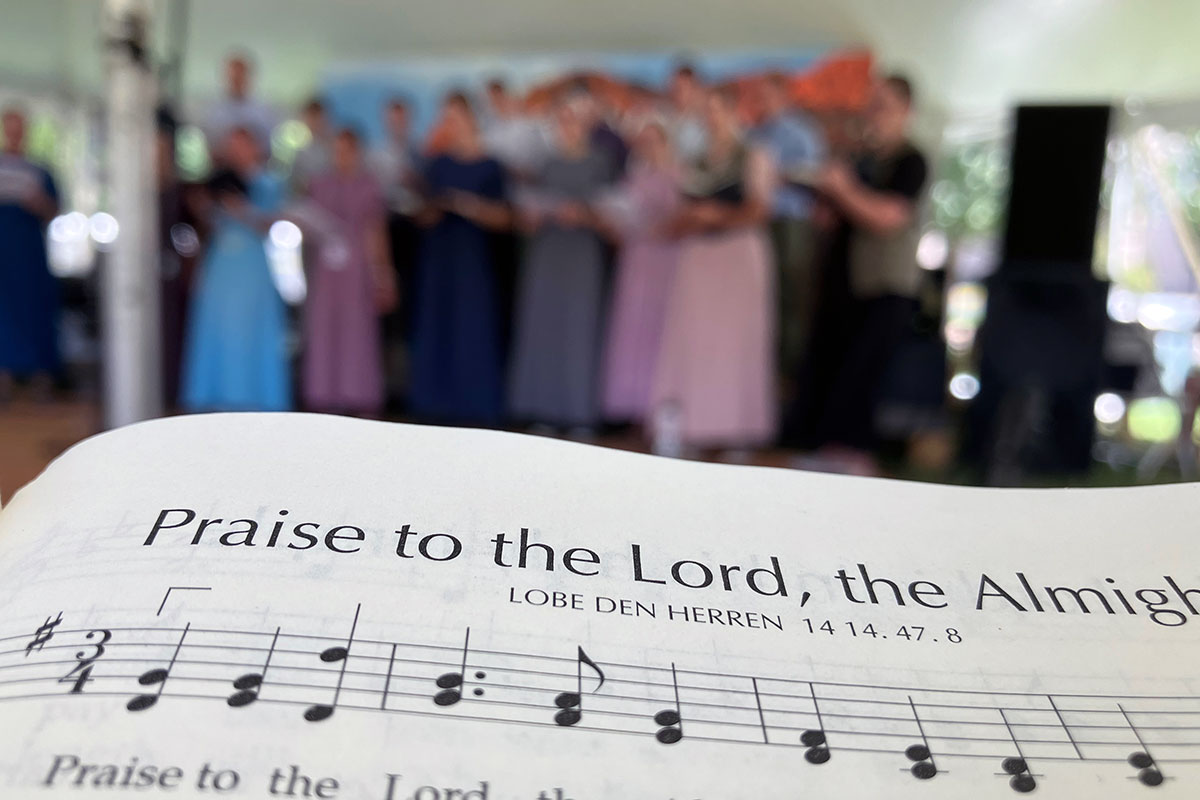Sanctuary in Song: Mennonite Harmonies, Together

Photo by Erin Roth
Editor’s note: At the 2023 Smithsonian Folklife Festival, members from local Mennonite churches led songs and conversations that explored congregational singing as living expressions of culture, faith, and tradition that help us make meaning as we move through the world. Erin Roth was among those participants, along with Pastor Nathan Zook, ethnomusicologist Jonathan Dueck, and folklorists Kathy Roberts and Cathy Hiebert Kerst.
I don’t remember how I learned to sing in harmony. But I do know that whenever we Mennonites gather, we harmonize.
Sunday mornings as a child, I would sit between my grandmother, an alto, and my mom, a soprano, absorbing their harmonies as I laid my head on their laps. When they stood to sing, I would stand on the pew leaning against my mother, sharing the work of holding the hymnal while she sang, and I pretended to follow the notes. Over time, I guess I developed an almost intuitive, relative sense of note-reading. I learned to sing the tenor line an octave above, just like my mom. She would sometimes song lead, a contribution to the worship service she shared with the other strong singers in the church. I became a song leader too, teaching new songs while keeping the best of the old ones.


Four-part a cappella singing is not unique to Mennonites. The singing schools of the early nineteenth century brought music literacy and four-part singing to Protestant churches across the United States. My grandfather, an Iowa farmer who was chosen by his church to be a pastor, untrained and unpaid, learned to read music from the shape-note method. As a young man, he sang tenor in a men’s quartet that traveled from church to church in the 1950s. In the 1970s, when my siblings and I were young, my mother formed her own quartet, sharing their music for Sunday evening programs.
Each person contributes to the worship service by “singing the church into being together,” as Jon Dueck writes. Congregational singing is central to the worship service that does not have a spoken liturgy. Anabaptism, the sixteenth-century religious movement from which Mennonites grew, was a rebellion of sorts against the hierarchy of the Catholic Church. Anabaptists convened directly with God without relying upon a priest to intercede.
Today, this belief is reflected in the many song leaders who are untrained musicians. The sanctuary is filled with music. Sitting amid these voices can be transcendent and, at times, a bit exposing. There is no place to hide when there is no organ or piano to support the voices, no soloist or practiced choir to lead. When one voice drops out, it’s noticed, especially in a small congregation. We can hear each other sing, compelling us to bend and support others.


Twenty years ago, I featured Anabaptist singing in a two-hour community radio program I hosted on WFHB in Bloomington, Indiana. My mother joined me in the studio to share her experiences with faith and music and a few songs from the record she made with the Eureka Ladies Quartet (8:50–36:00 in the playlist). I played records I had collected from Mennonite thrift stores and a field recording of Amish music sung by my friend’s grandparents (57:00–58:38). My own church, the Bloomington Mennonite Fellowship, came into the studio to sing from the hymnal (59:40–1:26:20).
I listened back to a recording recently and was reminded of the fellowship, small enough to meet in homes. A monthly potluck and hymn sing brought together people beyond our fellowship, some ethnically Mennonite, like me—though there are by far more Mennonites today who do not trace their history to Swiss-German or Prussian Mennonites. A cappella and in four-parts, we would sing with “intensity and seriousness,” as one fellowship member, Marvin Miller, said in the on-air interview. Another member, Kyle Schlabach, shared an insight that has stuck with me: “It’s really wonderful to sing with people you know well.”
According to my mother, my home church is doing less a cappella in four-part harmony singing than she would like. Outside musical trends have always shaped church music. What was once new to Mennonites is now a cherished tradition. Before four-part harmony, it was all unaccompanied unison. (The Amish continue to sing in this style.) What I have noticed is that even with the “new” music—often Christian praise and worship songs, accompanied by guitar, keyboard, or a drum set—Mennonites sing it in harmony.
The experience of being and doing community is central to Mennonite life. When we sing together, we renew our shared commitments to each other and to the larger human community. We love to sing. And we need each other to harmonize.

Erin Roth is a folklorist and researcher, most recently with the University of Maryland, Baltimore County. She currently attends North Baltimore Mennonite Church where she has served as song leader and accompanist.

